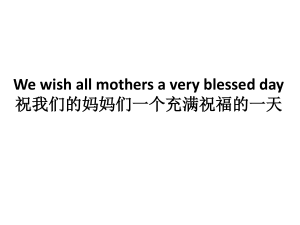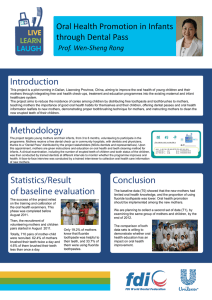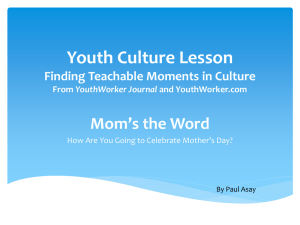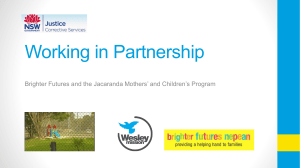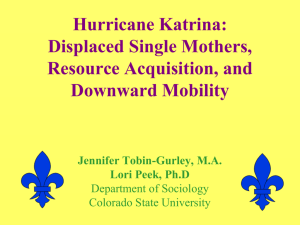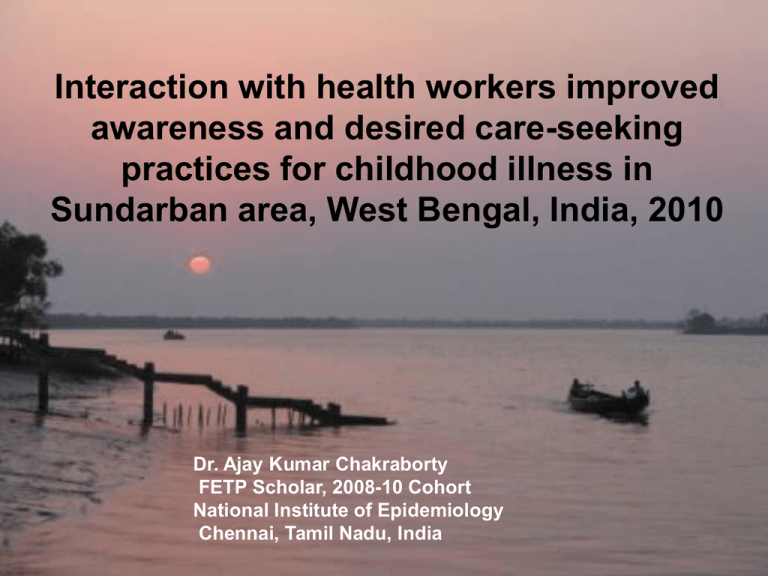
Interaction
with
health
workers
improved
Awareness
and
health
care-seeking
awareness
and
desired
care-seeking
practices for childhood illness in
practices for childhood illness in
Sundarban backward zone, West
Sundarban area, West Bengal, India, 2010
Bengal, India, 2010
Dr. Ajay Kumar Chakraborty
FETP Scholar, 2008-10 Cohort
National
Institute of Epidemiology
Dr. Ajay Kumar Chakraborty
FETP
Scholar, 2008-10
Chennai,
TamilCohort
Nadu, India
National Institute of Epidemiology
Chennai, Tamil Nadu, India
Background justification
• Delay in appropriate care seeking leads to
large number of child deaths globally
• Integrated Management of Neonatal and
Childhood Illness programme (IMNCI)
addressing this issue in India
– Improving management skill of health workers
– Educating mothers to identify danger signs and
seeking prompt care
• Before implementation, we assessed base
level situation in geographically vulnerable
Sundarban area of South 24 Parganas
district, West Bengal, India during 2010
2
Objectives
• Primary:
– Estimate the proportion of mothers aware of
danger sign of the ill children (<5 years) as per the
IMNCI guidelines
– Describe the help-seeking behaviour of the
mothers
• Secondary:
– Determine the factors associated with mothers’
awareness (at least 2 danger signs) and helpseeking behaviour
– Assess the knowledge of the peripheral health
workers (female) regarding the management of
“sick” children (<5 years)
3
Methodology
4
Study Area: Sundarban
South 24 Parganas District, WB
5
Study population, Study design,
Sampling
• Study population:
– The mothers of the <5 years old children in Sundarban area
(3.01 million), 24 Parganas (S) district, West Bengal, India
– The Health workers (F) [Auxiliary Nurse Midwife] of Sundarban
area
• Study design – Cross-sectional survey
• Sampling:
– Cluster sampling (Probability proportional to size) of 552 mothers
from 23 clusters (24/cluster)
• [Awareness 60% (UNICEF: MICS-India 2000), 95% CI , 90% power, roh 0.02, Right
size software]
– Random sampling of 117 Health workers (F)
• [Knowledge 50%, 95% CI, 80% Power, 20% absenteeism]
6
Data collection and Analysis
• Data collection procedure
– Team of two trained social workers interviewed mothers
– Pre-tested structured questionnaire in local language
– IMNCI module based questionnaire administered by BMOH to
the selected Health workers (F)
• Data entry and analysis
– Double entry, checked for consistency
– Analysis using Epi-info 3.5.1 version software
• Ethical Issues
– Approved by Ethical Committee, NIE-Chennai
– Informed consent, confidentiality, protection and support
7
Operational Definitions
• Danger sign: Child with any of the following sign or
symptoms (IMNCI guideline, GOI/WHO):
– Convulsions, unconsciousness, lethargy, vomits
everything, breast feeding poorly, drinking poorly,
‘become sicker’, develops Fever, ‘feels Cold to touch’
(young infant), fast breathing, difficulty in breathing,
blood in stool
• Prompt care: Sought help outside home within 24 hours
of the onset / identification of danger sign
• Appropriate care:
Approached for western system
of medicine (allopathic) either from a qualified private
practitioner or any government institute (including subcentre)
• Desired Care:
Availing appropriate care promptly
8
Result and Discussion
9
Socio-demographic status of Study sample,
Sundarban, 24Pgs, WB, 2010
Socio-Demographic
Indicators
Mother (n=549)
#
%
Father (n=549)
#
%
346
63
Economic statusBelow Poverty level (BPL)
262
48
Education- Illiterate
Up to Primary level
Above Primary
123
135
291
22
25
54
84
132
333
15
24
61
481
68
0
88
12
0
177
279
93
32
51
17
Religion-
Hinduism
OccupationHomemaker/Agriculture
Working/ Labors
Service or business
10
Demographic status of Study sample,
Sundarban, 24Pgs, WB, 2010
Demographic status
Mother (n=552)
#
%
60
9
215
265
72
39
48
13
Sex of Referent child- Male
299
54
Age group (Ref. Ch)- < 60 days
.
2 mo- 1 year
.
1-3 Year
3-5 Year
19
116
217
200
3.4
21
39.3
36
472
14
86
3
Previous child death (# of child)
# living child-
One
Two-Three
Four or more
.
Immunization:
.
Complete for Age
Not at all
11
Awareness of Danger signs among 552
mothers of Sundarban, 24Prgs, W.B. 2010
Develops Fever
Has difficult breathing
Can say 1
danger sign,
(33%, 95%CI-2540%)
Can not name
any danger sign,
(7%, 95%CI-3.611%)
Can say 2
danger signs,
(32%, 95%CI26-38%)
Vomits everything
Blood in stool
Lethargy
Has fast breathing
Can say > 3
danger signs
(28%, 95%CI-2136%)
Convulsions
Breast feeding poorly
Feels cold to touch
Unconsciousness
Drinking poorly
Became more ill
0
20
40
60
80
100
12
Illness and Help seeking behavior,
Sundarban, WB, 2010
Delayed
Care
Not Ill
Prompt
Care
(62%)
Inappropriate
Care
Illness,
60%
Others
Appropriate
Care
(36%)
Desired
Care
(28%)
Illness episodes
(N=552)
Care seeking (N= 331)
13
Choice of Provider (N= 331) Sundarban,
WB, 2010
Faith Healer- 0%
No Medicine
Other ISM Treat- shop 3%
ment
1%
5%
Govt SC
Non Qualified
4% (0.2%)
Private (Homeo
system)
Govt Institute
9%
12% (10%)
Non Qualified
Private (Western
system)
46%
Qualified Private
(Allopath)
13%
Private
Institue
7%
14
Determinants of Mothers’ Awareness of
at-least 2 danger signs (N= 552)
• Income:
– APL [AOR=1.5 (95% CI:1-2.1)]
• Religion:
– Muslim [AOR=1.8 (95% CI:1.1-2.7)]
• Source of information of danger signs
– Health Worker (F) [AOR=1.5 (95% CI-1.12.2)]
• Age of child 2mo- 2 year [OR= 1.3 (0.91.8)]
15
Mothers aware when source of
information was Health Workers
• Aware when HW(F) was source of information :
– Probably interaction during Immunization session as SC
utilization was low for care-seeking during illness
– During evaluation 88% found sharing key messages
– HW(F) exposed to several training on IEC/BCC
• Awareness with increasing child age:
– Peak at 1-2 yrs; corresponding to immunization age group
– Only when the ‘source of information’ was the health
workers (Chi sq for linear trend= 4.5 p = 0.03)
– Increased # of child not associated with awareness
16
Aware Muslim mothers : Any role of HW?
• Muslim mothers were Aware
– But SES likely to be poorer
• BPL [OR=1.4 (CI-1-2)]; uneducated [OR=3 (2-4.3)]
– Likely to have younger child
• More child below median age of 2 years (53% c.f.
Hindu 48%) – immunization age group
• Children mostly (95%,195/206) immunized, all from
Government source (HW-F)
– Better informed about Sub-centre working time [OR= 1.5
(1.04-2.1)]
• Probably indicate they are utilizing their services
17
Factors related with Care seeking
• Prompt care:
– With increasing # of danger signs [Chi sq for linear trend=7.06,
p=0.008]
– Aware Sub-centre working days [ AOR= 3.3, (1.2-9)]
• Appropriate care:
–
–
–
–
–
Mothers educated > primary level [ AOR= 4.6,(1.2-18)]
Husband in service/higher occupation [AOR= 5.5,(1.1-27)]
Preferred qualified allopathic services [AOR= 71,(13-394)]
System of choice was allopathic [AOR= 9.8, (1.7-58)]
Aware Sub-centre working days [ AOR= 3.4, 1-11]
18
Factors related with Desired Care
• Desired care:
– Preferred qualified allopath as 1st contact
[AOR= 16, 95% CI (3.8-67)]
– History of child death [AOR=15, (1.5-154)]
– Increasing awareness level [Chi sq for linear
trend= 3.5, p = 0.06]
– Aware Sub-centre working days [ AOR=
4.4, 1.2-15.5]
19
Interactions with HW lead to all desired
care-seeking behavior
• Interactions leading to desired care-seeking :
– All positive behavior associated with
‘knowledge of SC working time’
– We assumed correctly informed of ‘SC
working time’ - a surrogate for SC use and
therefore scope for interaction
– Mothers with child in immunization age group
better informed of ‘SC working time’ [1-2 year
48%(42-54%); 3-5 years 43%(37-49%)]
20
Knowledge score of Health Workers (F),
Sundarban, India, 2010
Knowledge Score
Health Workers (N=114)
Mean score
(proportion)
SD
Total score
New-born Care
60
89
10
22
Anemia and malnutrition
70
25
Identification of general danger sign
66
18
Management of Diarrhoea
61
17
Breast feeding
Management of ARI
58
55
28
18
8
18
Identification of common elements
21
Our limitations
• We have seen the association, dose response,
plausibility but could not confirm causal relationship
in absence of temporality
• We did not assess health workers’ contribution on
educating the community
– We rather accepted ‘keeping correct information
on Sub-centre functioning days’ as a surrogate
indicator for Sub-centre use
– We assumed Sub-centre use as synonymous to
interaction with health workers
• Based on previous observation
• Informally confirmed by the mothers
22
Conclusion..1
• Awareness level at par with Indian mothers
– In spite of all poor SES, but compared to India during 2000AD
• Mothers could identify most of the illnesses with
danger signs
• Prompt care a general practice, but not the
appropriate care
– Little gap in appropriate and desired care
– Inadequate qualified provider, available only in selected
areas, difficult communication
• Interactions with HW lead to better awareness and
desired care-seeking behavior
23
Conclusion..2
• Health assistant females have overall good
knowledge
– but weak in identification of common element and
case management
• Sub-centre utilization was low
– Better than the state. Alternate day service may be a
deterrent factor for utilization during emergencies
– For immunization purpose service utilization good
– Key messages shared during contacts
• Skill of behavioral changed communication
not assessed
– needs further assessment and planning
24
Recommendation
Implement IMNCI programme and train the
health workers
identification and management of common elements
including diarrhea and ARI based on IMNCI module
Extend the sub-centre working days to six
days
with the help of locally residing 2nd ANM
Further assessment of the communication
skill of health workers
To improve awareness and utilization of prompt and
appropriate services
25
Action taken
Findings shared with World-Bank
Data is being used for planning activity
Findings shared with District authority
Training of IMNCI has started, key identified
area getting more attention
Sub-centre started working six days a
week
Where 2nd ANM is available (prior Govt.
order)
26
Acknowledgement
• Faculty members of National Institute
of Epidemiology (NIE), Chennai, India
• District and Peripheral Health Workers,
South 24 Parganas District, WB
• Mothers of Sunderban area
27
28




